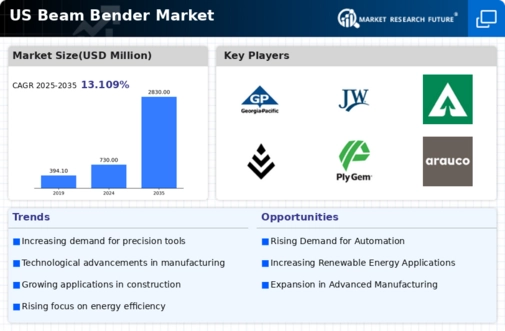Rising Demand in Manufacturing
The beam bender market experiences a notable surge in demand driven by the manufacturing sector. As industries increasingly adopt automation and precision engineering, the need for high-quality beam benders becomes paramount. In 2025, the manufacturing sector in the US is projected to grow by approximately 4.5%, which correlates with an increased requirement for advanced optical components. Beam benders play a crucial role in enhancing the efficiency of laser systems and optical devices, thereby supporting the overall productivity of manufacturing processes. This trend indicates a robust growth trajectory for the beam bender market, as manufacturers seek to optimize their operations through innovative technologies. The integration of beam benders into various manufacturing applications is likely to propel market expansion, reflecting the industry's commitment to adopting cutting-edge solutions.
Emergence of Smart Technologies
The emergence of smart technologies is reshaping the landscape of the beam bender market. As industries increasingly adopt smart manufacturing and IoT solutions, the demand for precision optical components rises. In 2025, the smart technology market in the US is projected to grow by approximately 15%, creating new opportunities for beam bender applications in automation and control systems. Beam benders are essential for ensuring accurate light manipulation in smart devices, which enhances their functionality and performance. This trend suggests that the beam bender market will likely experience growth as manufacturers integrate these components into their smart technology offerings, reflecting a broader shift towards intelligent systems.
Growth in Research and Development
The beam bender market benefits significantly from the escalating investments in research and development (R&D) across various scientific fields. In 2025, R&D spending in the US is expected to reach approximately $700 billion, with a substantial portion allocated to optics and photonics. This investment fosters innovation and the development of advanced beam bending technologies, which are essential for experimental setups in laboratories and research institutions. The increasing focus on precision measurement and high-performance optical systems drives the demand for sophisticated beam benders. As researchers seek to push the boundaries of knowledge, the beam bender market is likely to see a corresponding rise in demand, reflecting the critical role these components play in scientific advancements.
Increased Focus on Defense and Aerospace
The beam bender market is positively impacted by the heightened focus on defense and aerospace applications. In 2025, defense spending in the US is anticipated to exceed $800 billion, with a significant portion directed towards advanced optical systems for surveillance, targeting, and communication. Beam benders are vital components in various defense technologies, including laser systems and imaging devices. The growing emphasis on national security and technological superiority drives the demand for high-performance optical components, thereby benefiting the beam bender market. As defense contractors seek to enhance their capabilities, the integration of advanced beam bending solutions is likely to become more prevalent, indicating a promising outlook for the market.
Expansion of the Telecommunications Sector
The telecommunications sector's expansion significantly influences the beam bender market. With the ongoing rollout of 5G technology and the increasing demand for high-speed data transmission, optical components, including beam benders, are becoming essential. In 2025, the US telecommunications industry is projected to grow by around 6%, driven by the need for enhanced connectivity and data services. Beam benders are integral to the functioning of fiber optic systems, which are crucial for supporting the infrastructure required for 5G networks. This growth in telecommunications not only boosts the demand for beam benders but also encourages innovation in optical technologies, thereby enhancing the overall market landscape.



















Leave a Comment